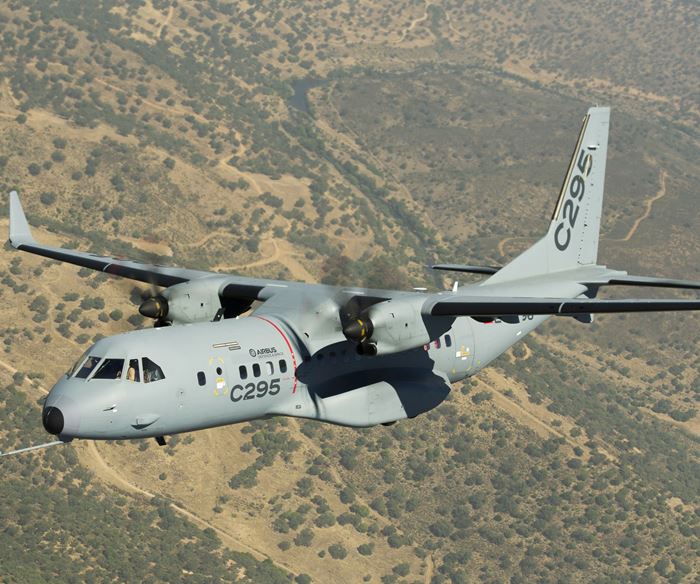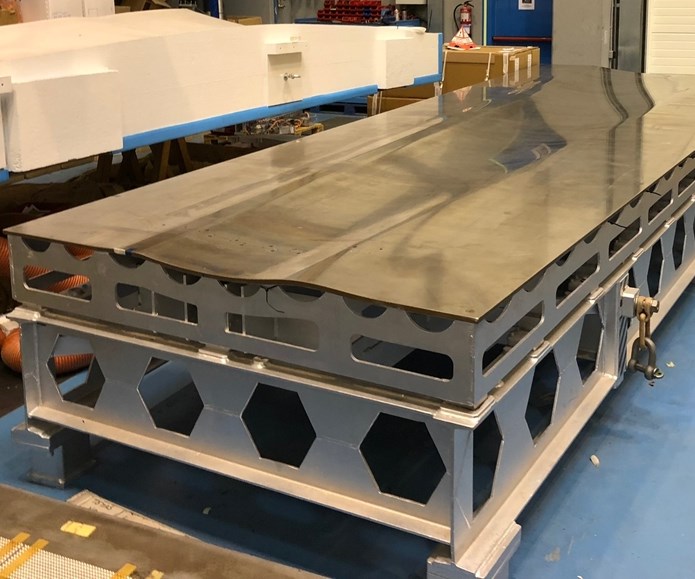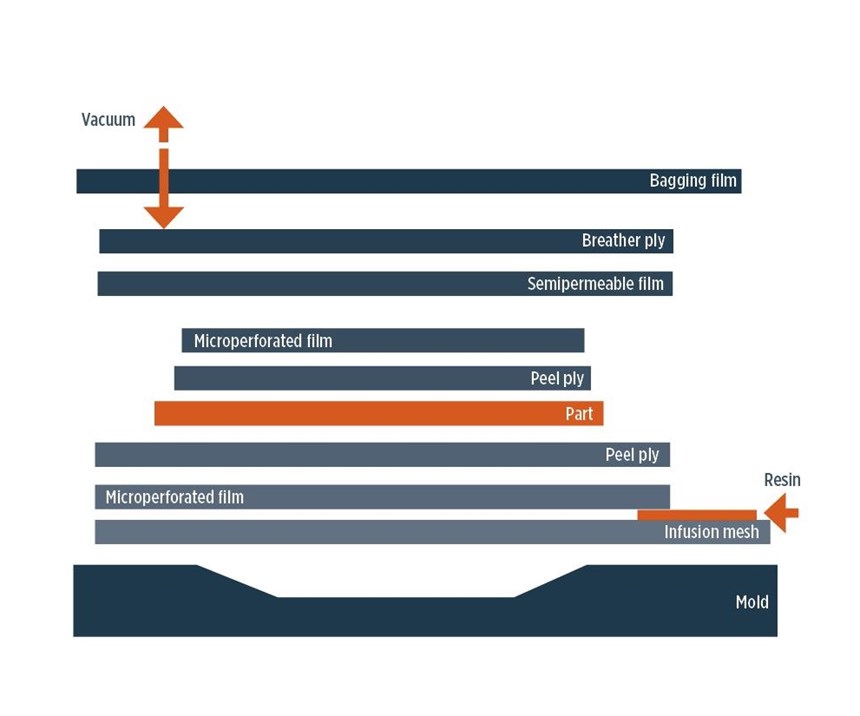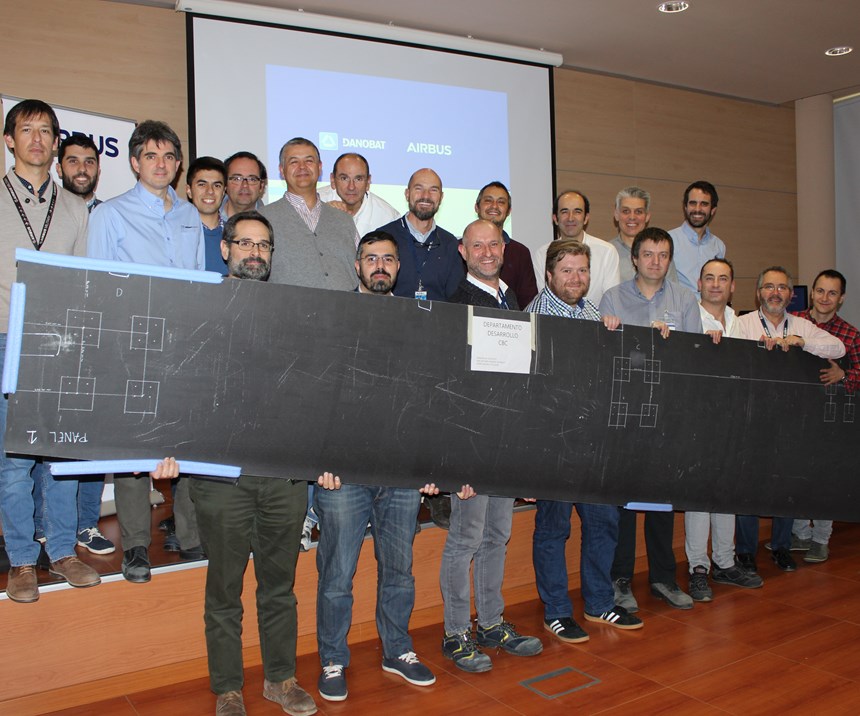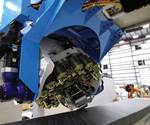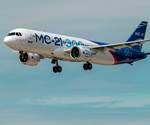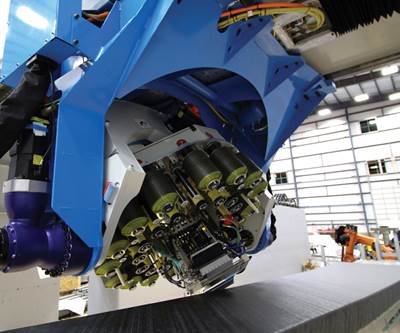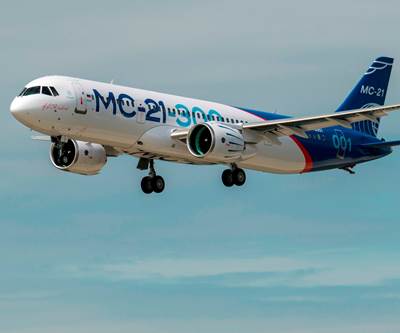Proving viability of dry fabrics, infusion for large aerostructures
Danobat’s ADMP is used to produce a wing demonstrator with non-crimp fabrics.
CW has covered several new aerostructure fabrication innovations unheard of a decade ago. Joining those now is a demonstrator wing skin project, unveiled at JEC World 2018, that also breaks new ground. The project is a result of collaboration between Danobat (Elgoibar, Spain) and Airbus Defense and Space (Airbus DS, Cadiz, Spain) and comprises a composite wing skin fabricated using Danobat’s high-speed Automated Dry Material Placement (ADMP) technology, which is well known for rapidly laying wide multiaxial and broadgoods preforms for infusion in wind blade and aerospace manufacturing. The wing skin development partners agreed to share some of this breakthrough project’s details with CW.
Swapping prepreg for NCF
Almost all aerostructures are made today with prepreg materials, which require autoclave cure. But a definite trend is emerging that aims to get aerostructures out of the autoclave. That’s the premise behind the wing demonstrator, says Asier Gandarias Mintegi, Danobat’s manager of composites business development: “Our goal is to show the feasibility of manufacturing aircraft components by means of fully automated, dry, multiaxial non-crimp fabric deposition, to achieve disruptive high production rates.”
First, a bit of explanation and background on Danobat’s trademarked and proprietary ADMP technology. The ADMP automated work cell, with its layup end effector, deposits dry multiaxial or woven material, or dry tape, in any type of tooling. Gandarias Mintegi says that depending on the requirements of the final application, ADMP can lay down widths from 100 millimeters up to 2 meters or more at rates of up to 2 meters per second. Further, the system has the capability to lay a constant-width roll, or to follow a pattern previously cut to the final dimensions required by the application. Because of the high deposition speed, the system, says the company, provides preforms with improved quality for higher productivity and throughput, at reduced labor cost.
To test this technology in a practical way for aerostructure manufacturing, the Airbus DS and Danobat team employed ADMP to make the upper skin for the outer wing section of a C295 aircraft. The C295 is a twin-turboprop tactical military transport aircraft currently manufactured in aluminum by Airbus DS in Spain. The outer, upper wing skin was 5,700 millimeters long, 1,170 millimeters wide at the root, 650 millimeters wide at the tip; and 4-5.5 millimeters thick. Luis Rubio Garcia, senior expert in composite manufacturing engineering at Airbus DS, says that the wing skin, dimensioned according to the known operational loads of an integral composite wing box based on a multispar configuration, is just a first step in technology development: “While the design was dimensioned for prepreg, we adapted it for NCF fabrics. Our design tools are the standard software packages used by Airbus.”
Fabrics chosen for the dry layup were a combination of 0/90, ±45 and 0 degrees non-crimp fabrics (NCF), supplied by Saertex GmbH & Co. KG (Saerbeck, Germany). Rubio Garcia explains that these multiaxial carbon fiber fabrics are made with a customized stitching pattern and areal weight. The fabrics included a Hexion Inc. (Columbus, Ohio, U.S.) Epikote powder binder as qualified under an Airbus Specification (Epikote 05311). Figure 1 shows the laminate architecture, and the order in which the fabrics were placed. Eight plies make up the majority of the skin, with a final thickness of 4 millimeters, while 12 plies were placed in the root area and wing tip, for a final thickness of 5.5 millimeters. Gandarias Mintegi explains that the ply drop-off ratio from the thicker root and tip areas to the middle part of the skin was 1:20, or a 1-millimeter drop over a 20-millimeter distance.
Tooling for the demonstrator wing skin was an existing metallic tool with an Invar face (Fig. 2) built for an earlier phase of C295 research to determine the feasibility of a multispar composite wing using prepreg. The ADMP with its fabric-handling end effector laid the entire laminate within 48 minutes in the shallow tool, which was prepped with a Loctite Frekote 700-NC mold release from Henkel (Dusseldorf, Germany), micro-perforated film and peel ply for the infusion, explains Gandarias Mintegi. The ADMP system was able to automatically adjust to each of the fabric types without the need for activating the binder on the fabrics (to keep them from slipping), and each ply was placed in the tool in one pass, because of the ADMP’s width. He adds: “The time was measured to determine an order of magnitude for this development trial, under conservative conditions, and at 48 minutes we achieved the target proposed within the scope of the trial. This productivity corresponds to 90 kg/hr in a trial mode and can be extrapolated under current conditions up to 220 kg/hr for a mass production mode, once the technology is matured and tuned.”
Infusing a fabric wing
While the laminating technology is well-developed, infusing the laminate took more time. The team employed the Airbus method, which is based on a semi-permeable membrane system to remove air from the fabric layups. As shown in Figure 3, the layup was covered with another peel ply, followed by another micro-perforated film, a semi-permeable film and a breather layer, all enclosed within the bagging film. Consumables were manufactured by Airtech International Inc. (Huntington Beach, Calif., U.S. and Differdange, Luxembourg), except for the semi-permeable film, which came from Diatex SaS (Saint Genis Laval, Rhone Alpes, France), and were supplied to the team by Airbus DS.
The infusion resin was CYCOM 823 RTM epoxy from Solvay (Alpharetta, Ga., U.S.), a one-part room-temperature-injectable epoxy that had been previously qualified by Airbus in aerospace programs. “All of the materials and consumables were chosen to allow us to perform the infusion at room temperature and the cure at 120°C,” says Gandarias Mintegi. The total time to bag, infuse and cure the part, including heating the tool and the layup with heating blankets, was approximately eight hours, he adds, under the conditions of the demonstration project.
The cured demonstrator wing skin has undergone a battery of tests so far, reports Rubio Garcia: “Airbus DS followed its standard test procedures for this demonstrator, including non-destructive inspection, geometrical tolerance tests, fiber volume percent and degree of cure. The results are equivalent to the current prepreg reference for the part.” The team intends to continue developing dry fabric manufacturing methods for primary aerostructures.
Conclude Gandarias and Rubio Garcia, “So far, results have been very promising. Further development and demonstration activities are already being carried out towards the industrialization of the whole manufacturing process, including the integration of spar and stringers.” They add that the plan is to manufacture a new, second dry fabric (NCF) demonstrator shortly, under the Project Airbus DS 2020 roadmap, and CW will continue to follow this disruptive technology.
Related Content
ASCEND program update: Designing next-gen, high-rate auto and aerospace composites
GKN Aerospace, McLaren Automotive and U.K.-based partners share goals and progress aiming at high-rate, Industry 4.0-enabled, sustainable materials and processes.
Read MoreThe potential for thermoplastic composite nacelles
Collins Aerospace draws on global team, decades of experience to demonstrate large, curved AFP and welded structures for the next generation of aircraft.
Read MoreCryo-compressed hydrogen, the best solution for storage and refueling stations?
Cryomotive’s CRYOGAS solution claims the highest storage density, lowest refueling cost and widest operating range without H2 losses while using one-fifth the carbon fiber required in compressed gas tanks.
Read MoreWelding is not bonding
Discussion of the issues in our understanding of thermoplastic composite welded structures and certification of the latest materials and welding technologies for future airframes.
Read MoreRead Next
Improving composites processing with automated inspection
Automated, in-situ inspection bypasses the bottleneck of manual inspection.
Read MoreInfused wing sheds light on aerocomposites future
In the Irkut MS-21 infused and co-cured wings, the aerocomposites industry gets a glimpse of how out-of-autoclave technologies might be applied to primary aircraft structures.
Read MoreVIDEO: High-volume processing for fiberglass components
Cannon Ergos, a company specializing in high-ton presses and equipment for composites fabrication and plastics processing, displayed automotive and industrial components at CAMX 2024.
Read More

